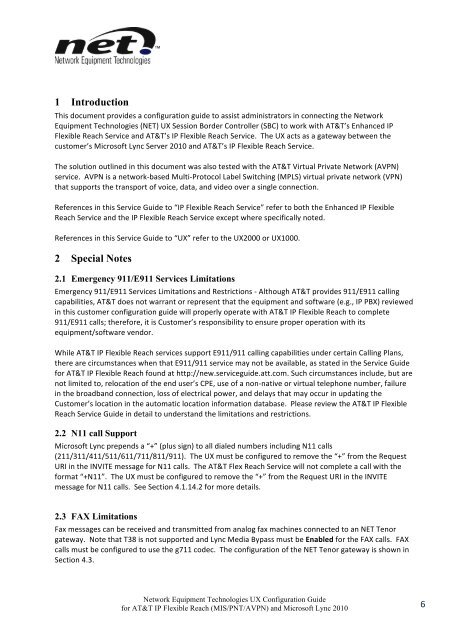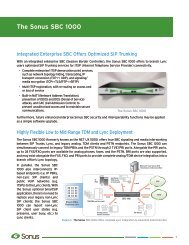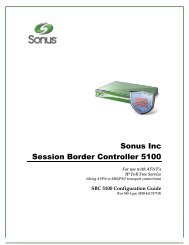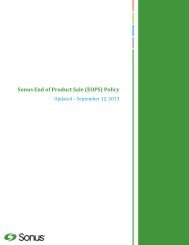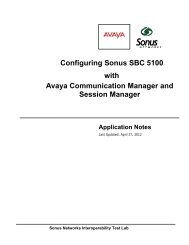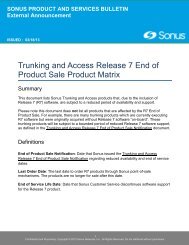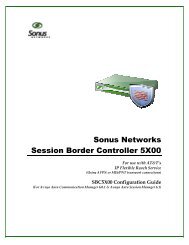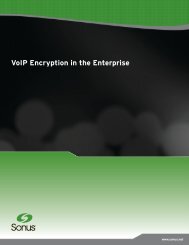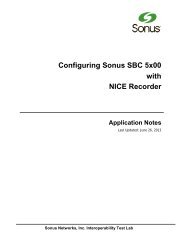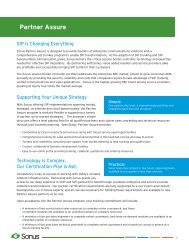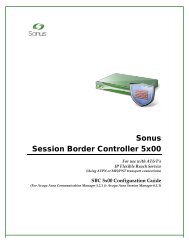Sonus SBC 1000 / SBC 2000 Configuration Guide - Sonus Networks
Sonus SBC 1000 / SBC 2000 Configuration Guide - Sonus Networks
Sonus SBC 1000 / SBC 2000 Configuration Guide - Sonus Networks
- No tags were found...
You also want an ePaper? Increase the reach of your titles
YUMPU automatically turns print PDFs into web optimized ePapers that Google loves.
1 IntroductionThis document provides a configuration guide to assist administrators in connecting the Network Equipment Technologies (NET) UX Session Border Controller (<strong>SBC</strong>) to work with AT&T’s Enhanced IP Flexible Reach Service and AT&T’s IP Flexible Reach Service. The UX acts as a gateway between the customer’s Microsoft Lync Server 2010 and AT&T’s IP Flexible Reach Service. The solution outlined in this document was also tested with the AT&T Virtual Private Network (AVPN) service. AVPN is a network-‐based Multi-‐Protocol Label Switching (MPLS) virtual private network (VPN) that supports the transport of voice, data, and video over a single connection. References in this Service <strong>Guide</strong> to “IP Flexible Reach Service” refer to both the Enhanced IP Flexible Reach Service and the IP Flexible Reach Service except where specifically noted. References in this Service <strong>Guide</strong> to “UX” refer to the UX<strong>2000</strong> or UX<strong>1000</strong>. 2 Special Notes2.1 Emergency 911/E911 Services LimitationsEmergency 911/E911 Services Limitations and Restrictions -‐ Although AT&T provides 911/E911 calling capabilities, AT&T does not warrant or represent that the equipment and software (e.g., IP PBX) reviewed in this customer configuration guide will properly operate with AT&T IP Flexible Reach to complete 911/E911 calls; therefore, it is Customer’s responsibility to ensure proper operation with its equipment/software vendor. While AT&T IP Flexible Reach services support E911/911 calling capabilities under certain Calling Plans, there are circumstances when that E911/911 service may not be available, as stated in the Service <strong>Guide</strong> for AT&T IP Flexible Reach found at http://new.serviceguide.att.com. Such circumstances include, but are not limited to, relocation of the end user’s CPE, use of a non-‐native or virtual telephone number, failure in the broadband connection, loss of electrical power, and delays that may occur in updating the Customer’s location in the automatic location information database. Please review the AT&T IP Flexible Reach Service <strong>Guide</strong> in detail to understand the limitations and restrictions. 2.2 N11 call SupportMicrosoft Lync prepends a “+” (plus sign) to all dialed numbers including N11 calls (211/311/411/511/611/711/811/911). The UX must be configured to remove the “+” from the Request URI in the INVITE message for N11 calls. The AT&T Flex Reach Service will not complete a call with the format “+N11”. The UX must be configured to remove the “+” from the Request URI in the INVITE message for N11 calls. See Section 4.1.14.2 for more details. 2.3 FAX LimitationsFax messages can be received and transmitted from analog fax machines connected to an NET Tenor gateway. Note that T38 is not supported and Lync Media Bypass must be Enabled for the FAX calls. FAX calls must be configured to use the g711 codec. The configuration of the NET Tenor gateway is shown in Section 4.3. Network Equipment Technologies UX <strong>Configuration</strong> <strong>Guide</strong>for AT&T IP Flexible Reach (MIS/PNT/AVPN) and Microsoft Lync 20106


